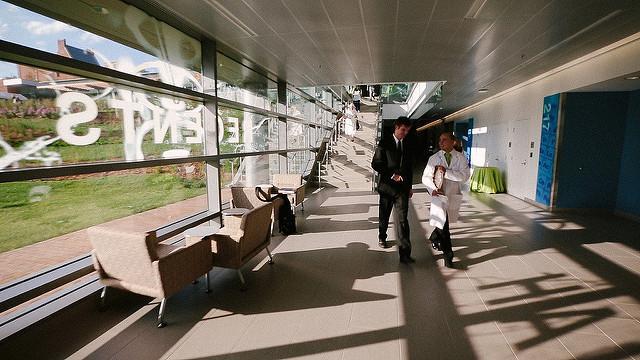At a seminar hosted by the physics department, a Georgetown graduate spoke to students and faculty about how chromosomes assume their characteristic “X” shape during cell division.
The Jan. 31 talk, titled “How protein motors shape chromosomes,” featured Dr. Edward J. Banigan (COL ’07), a research scientist at the Massachusetts Institute of Technology who specializes in biological physics. Banigan’s Ph.D. work introduced him to this field of physics.

“What struck me about this is that this fundamental biological process involved many basic physical concepts: e.g., how do cells generate and react forces? It immediately shifted my entire idea of what biophysics can entail,” Banigan wrote to The Hoya.
Banigan’s most recent work seeks to understand how the loose, spaghetti-like strands of DNA floating in the cell’s nucleus become dense chromosomes, the genetic material involved in cell division, in a process called chromosome compaction.
In his talk, Banigan said it takes around 30 minutes for chromosomes to switch between their two forms — decondensed and condensed — which, according to Banigan, is a surprisingly short amount of time for such a complex process to take place. He also researches patterns of how different chromosomes come into contact with each other.
Banigan’s research on chromosome compaction has wide-reaching impacts, since improper execution of the mechanism can cause cells to become dysfunctional, potentially giving rise to cancer.
Banigan said the biomedical impact of his research is part of what motivates him.
“As a scientist, I think the pursuit of this knowledge is worthwhile in itself, but I also think the biomedical relevance makes this kind of work potentially important for societal benefit in the long run.”
To investigate how DNA strands are wound into rod-like chromosomes, Banigan employs a variety of techniques including genome sequencing. Genome sequencing allows him to unpack how different parts of the genome, and which parts of the chromosomes, are in contact with each other.
“These experiments basically freeze cells (and their genomes) in space, cut the genome into tiny pieces, glue the pieces to whatever other chromosomal fragments are nearby, and then sequence the new DNA fragments,” Banigan wrote.
“The result is that we can map out which pieces of chromosome were physically near which other pieces of chromosome,” he added.
Banigan studies the ways specific proteins attach to the DNA and push the DNA through to form loops, a process known as loop extrusion. This mechanism allows chromosomes to take up less space in the nucleus of the cell, which allows for the genetic material to be divided correctly.
“I think the overarching narrative about the ways in which loop extrusion organizes chromosomes is my biggest contribution to science,” Banigan wrote.
The seminar was part of the Physics Colloquium, a series of research talks organized by the Physics department. The colloquia are held every two weeks and feature talks by researchers from Georgetown and other institutions.
Professor Amy Liu, the chair of Georgetown’s physics department, said the department started the colloquia to provide a platform for scientists to share and learn about novel research.
“Colloquium is a practice that enriches the intellectual life of our community,” Liu wrote in an email to The Hoya.
Liu said faculty and student interests are the main factor the department considers when choosing speakers.
Professor David Egolf, Banigan’s undergraduate research mentor at Georgetown, said that the talks are intended for a wide range of audiences.
“The target audience generally includes graduate students, advanced undergraduates, and faculty members in physics, but, for Dr. Banigan’s talk, there were also biochemists and biologists in the audience since he applies statistical physics concepts to the study of biomolecules,” Egolf wrote.
The next seminar, which will take place Feb. 14, will feature Peter Schiffer, a physicist at Yale University. Schiffer will speak about his research on artificial spin ice, a material designed to have magnetic properties that are not naturally occurring, to understand geometric “frustration”.
Social media caption: Dr. Edward Banigan, an MIT science researcher, spoke about his work on the mechanics of transforming loose strands of DNA into chromosomes ready for cell division, in the latest seminar of the Physics Colloquium, hosted by Georgetown’s Physics Department every two weeks. The seminars are hosted every two weeks, and all students are welcome to attend.









